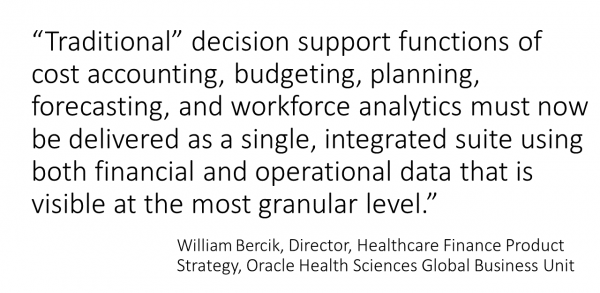 When we take a look at the hot topics for #HIMSS16 it is no surprise that cost management is on the list. Healthcare organizations are continuing to understand the value of enterprise-wide transparency in order to lower the cost of care and improve the quality of care for the populations they serve. For that to happen data and organizational silos must be knocked down.
When we take a look at the hot topics for #HIMSS16 it is no surprise that cost management is on the list. Healthcare organizations are continuing to understand the value of enterprise-wide transparency in order to lower the cost of care and improve the quality of care for the populations they serve. For that to happen data and organizational silos must be knocked down.
Today, I sat down with William Bercik, a former CFO and current Director, Healthcare Finance Product Strategy, Oracle Health Sciences Global Business Unit to talk about cost management and the importance of correlating cost and quality of care. William has over 25 years of experience in the healthcare industry and has specialized in enterprise applications and technology solutions since 1992. He provides specialist product expertise and develops and executes solution strategies for the healthcare market. Prior to joining Oracle, William was a chief financial officer for an acute care hospital.
KATE: Speaking as a former Hospital CFO, what role does data play in an organization understanding their costs?
WILLIAM: Payment reform is creating a big shift in care delivery, from higher revenue and higher margin acute services to lower revenue and lower margin out-patient care, with a focus on good patient experience tied to good clinical outcomes. Health systems will need to adopt a data-driven and technology enabled delivery model across the continuum of care, including pre-operative, intra-operative, and post-operative services, to manage cost and achieve the best financial and clinical outcomes across cases and episodes of care and attributed populations. “Traditional” decision support functions of cost accounting, budgeting, planning, forecasting, and workforce analytics must now be delivered as a single, integrated suite using both financial and operational data that is visible at the most granular level. This is necessary in order to provide multiple, seamless, real-time lenses on the health system’s short and long-term performance against the performance measures of value-based care. For example, stakeholders should be equipped with predictive modeling insights into the impact of changing patient volume on costs and profitability.
KATE: Talk about the importance of having a strong partnership between clinical and financial leaders?
WILLIAM: An effective cost management and value-based care delivery strategy requires coordinated buy-in and engagement from stakeholders across the enterprise. This shared cost and quality accountability strategy should be driven by specific, actionable insights derived from a single source of truth: an enterprise-wide data repository. Relevant performance indicators and forecasted trends must be delivered at the right time, in each manager’s specific decision-making workflow providing transparency and traceability to engender credibility and not only measure performance but also improve it through organizational activities.
KATE: Why is transparency important and how can an organization achieve financial transparency?
WILLIAM: Transparency, within the cost allocation process, is providing traceability to address any skepticism about the accuracy of the numbers. Advanced costing solutions must both enable multiple methods of modeling (cost allocations) and provide drill-down visibility into the step-down allocation at the most granular level, including unallocated costs and general ledger reconciliation. At any point in the model, a stakeholder should be able to trace backward or forward, easily visualizing the defined allocation flow. An enterprise view of these traceable cost allocations, linked with key performance indicators that are correlated with clinical and financial data describes a fully transparent performance management process.
KATE: What is micro-costing and what is the value for healthcare?
WILLIAM: “Micro-costing” is a valuation method in health economics, where the unit of analysis is the individual or individual service in panel or time series. Provider costing has historically been isolated from the true costs and has relied on step-down allocations or averages that fail to match resources and related costs to their services. Micro- costing enables providers to organize services used across the multiple patient encounters into episodes of care or bundled services definitions, and they also enable providers to examine care path and corresponding cost variations. Such modeled services bundles can be informative for contract negotiations. Moreover, the abilities for health systems to create hierarchies of patient populations based on clinical and financial risk will be pivotal to their abilities to manage these patients under value-based payments.
KATE: What are some of the cutting-edge technology solutions that can help correlate cost and quality?
WILLIAM: An effective population health strategy in an era of healthcare reform demands a comprehensive, pervasive, and data-driven financial decision support portfolio operating from a single unified source of high-quality reliable data across financial, clinical and operational functions. Health-care organizations that deploy an advanced, business-user configurable decision support solution such as the Perficient High-Performance Costing Expressway can avoid big bang investments and progressively harness targeted data sources to gain insight across the care continuum while leveraging evolving best
You can learn more about the Perficient High-Performance Costing Expressway solution at the Population Health Knowledge Center, Kiosk #14106 on Wednesday, March 2, from 4:00-6:00 PM PST. Add to Calendar



